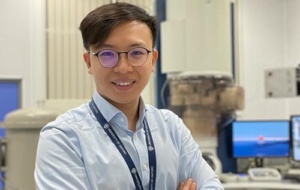M&M Portland, Oregon
 Keasbey Travel Grants Report – Ping-Luen (Baron) Ho (2018, DPhil Inorganic Chemistry)
Keasbey Travel Grants Report – Ping-Luen (Baron) Ho (2018, DPhil Inorganic Chemistry)
Portland, Oregon, USA 31 July to 4 August 2022
With the generous fund from Univ’s Keasbey Travel Grants, I attended Microscopy and Microanalysis (M&M) conference in United States for the first time. The biggest microscopy event of the year comes to Portland, Oregon for an amazing summertime conference of education and scientific exploration. The Microscopy Society of America (MSA) and the Microanalysis Society (MAS) organised this domestic meeting every year, and it has become an annual international conference with over 1200 platform and poster sessions, workshops, tutorials, and networking events, in addition to four days of the world’s largest Microscopy products and services commercial expo hall in the world. M&M attracts many scholars and technicians coming to exchange ideas and latest technology.
M&M2022 has four symposia – Analytical Sciences, Biological Sciences, Physical Sciences and Cross-Cutting Sciences. Each session discussed microanalysis broadly encompasses any analytical method for determination of materials properties at the micrometer and smaller size scale, or microgram or smaller mass scale. Today, tremendous advances in light microscopic methods have shifted many biological applications away from electron microscopy (EM), while the importance of EM in nanotechnology and materials science has steadily grown over the last twenty years. As a result, EM applications are now rather evenly important between biological and materials applications.
My DPhil topic is focusing on identifying the spatial differentiation in a beam sensitive material – zeolite by EM. This work faced big challenges that the trials and tribulations of electron-beam sample interactions in these years. Understanding, controlling, and reducing electron-beam sample interactions is essential to meaningfully correlate the synthesis, chemistry, properties between organic and inorganic materials or semiconductors. I demonstrated our latest results that address challenges in electron-beam sample interactions that enable the reliable collection of data. I expect that our work advances and contributions can help people to understand the complex metal oxides and structures of frameworks, properties, and dynamics through low-dose imaging, 4D-STEM and pixelated detectors, exit wave reconstruction, fast scanning and image overlapping, ptychography, machine learning, and theoretical aspects.
I not only experienced American culture and lifestyle a lot in this time, but also learned relevant knowledge from many talents and peers so much. At the same time, they all encouraged me to stay true to my original passions when encountering the countless difficulties in scientific research. It certainly took my mind off the 14-hour long flight, it is worth!
Find out more about the range of travel grants and scholarships available to assist Univ students on our Travel Grants page or read further travel reports.
Published: 17 November 2022
